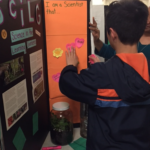Research
Science in the Learning Gardens
Factors that Support Racial and Ethnic Minority Students’ Success in Low-Income Middle Schools
PI: Dilafruz Williams
Co-PIs: Sybil Kelley, Cary Sneider, Ellen Skinner
Funded by: National Science Foundation-DRL/DRK12 # 1418
September 1, 2014-August 31, 2017
Overview
Science in the Learning Gardens (SciLG) proposes to address two inter-related educational needs in Science, Technology, Engineering, and Mathematics (STEM) that are well-documented: underrepresentation of racial and ethnic minority students (henceforth, minority students); and inadequacies of curriculum and pedagogy to address their cultural and motivational needs. By focusing on 6th – 8th grade science that will be aligned with Next Generation Science Standards (NGSS) to cover Science and Engineering Practices, Crosscutting Concepts, and Disciplinary Core Ideas articulated with school gardens as the milieu for learning, SciLG will study factors that support success of minority students (e.g., relatedness, competence, and purpose and autonomy) using a theoretical model of motivational engagement.
Project Goals
- To design and implement Science in the Learning Gardens (SciLG) curriculum that aligns with Next Generation Science Standards (NGSS), using school gardens as learning contexts in grades 6, 7, and 8.
- To investigate the extent to which SciLG project activities predict students’ STEM identity, motivation, learning, and grades in science using a model of motivational development.
Setting
SciLG is implemented in grade 6 (2014-15), grade 7 (2015-16), and grade 8 (2016-17) in two urban schools. It is supported by science teachers and a multidisciplinary team of university educators and community members.
Partnership Model

Click here for a larger version [PDF]
Papers
- Skinner, E.A., Chi, U., & the Learning-Gardens Educational Assessment Group (in press, 2018). What Role Does Motivation and Engagement in Garden-based Education Play for Science Learning in At-Risk Middle School Students? A Self-determination Theory Perspective. In M. Barnett, A. Patchen, L. Esthers, & N. Kloboch (Eds.), Urban Agriculture and STEM Learning, vol. 1. Research Perspectives. New York: Springer.
Conference Presentations
- Williams, D., Brule, H., Skinner, E., Kelley, S., & Lagerwey, C. (2016, April). Science in the Learning Gardens: Engagement and Learning in Sixth Graders from Low-Income Diverse Schools. Paper presented at the annual meeting of the American Educational Research Association, Washington, D.C.
- Williams, D., Brule, H., Skinner, E., & Kelley, S. (2017, April). Diversity and the Promise of Science in the Learning Gardens: Students’ Motivation, Achievement, and Science Identity in Low-Income Middle Schools. Paper presented at the annual meeting of the American Educational Research Association, San Antonio, TX.
Poster
Instruments by Ellen Skinner
For further information about these instruments, please contact Dr. Skinner.
PDFs
Microsoft Word Documents
- Student Survey with item codes
- Teacher Survey with item codes
- Coding Key
- Items by Construct
- Variables and Formulas
Video
2017
2016





